(Press-News.org) Space scientists at the University of Leicester have detected a curious signal in the X-ray sky – one that provides a tantalising insight into the nature of mysterious Dark Matter.
The Leicester team has found what appears to be a signature of 'axions', predicted 'Dark Matter' particle candidates – something that has been a puzzle to science for years.
In a study being published on Monday 20 October in the Monthly Notices of the Royal Astronomical Society, the University of Leicester scientists describe their finding of a signal which has no conventional explanation.
As first author Professor George Fraser, who sadly died in March of this year, wrote: "The direct detection of dark matter has preoccupied Physics for over thirty years." Dark Matter, a kind of invisible mass of unknown origin, cannot be seen directly with telescopes, but is instead inferred from its gravitational effects on ordinary matter and on light. Dark Matter is believed to make up 85% of the matter of the Universe.
"The X-ray background - the sky, after the bright X-ray sources are removed - appears to be unchanged whenever you look at it," explained Dr. Andy Read, also from the University of Leicester Department of Physics and Astronomy and now leading the paper. "However, we have discovered a seasonal signal in this X-ray background, which has no conventional explanation, but is consistent with the discovery of axions."
This result was found through an extensive study of almost the entire archive of data from the European Space Agency's X-ray observatory, XMM-Newton, which will celebrate its 15th year in orbit this December. Previous searches for axions, notably at CERN, and with other spacecraft in Earth orbit, have so far proved unsuccessful.
As Professor Fraser explains in the paper: "It appears plausible that axions – Dark Matter particle candidates - are indeed produced in the core of the Sun and do indeed convert to X-rays in the magnetic field of the Earth." It is predicted that the X-ray signal due to axions will be greatest when looking through the sunward side of the magnetic field because this is where the field is strongest.
Dr. Read concludes: "These exciting discoveries, in George's final paper, could be truly ground-breaking, potentially opening a window to new physics, and could have huge implications, not only for our understanding of the true X-ray sky, but also for identifying the Dark Matter that dominates the mass content of the cosmos."
President of the Royal Astronomical Society Professor Martin Barstow, who is Pro-Vice-Chancellor, Head of the College of Science & Engineering and Professor of Astrophysics & Space Science at the University of Leicester said: "This is an amazing result. If confirmed, it will be first direct detection and identification of the elusive dark matter particles and will have a fundamental impact on our theories of the Universe."
INFORMATION:
FUNDING ACKNOWLEDGEMENT:
The XMM-Newton observatory, its operations and data archive, constitute a major international collaboration within the European Space Agency (ESA) member states and beyond. The work of a number of authors on the calibration of XMM-Newton was supported by the UK Space Agency (UKSA).
NOTES TO EDITORS. For more information contact:
Dr. Andy Read
University of Leicester
amr30@le.ac.uk
+44 (0)116 252 5650
Dr. Steve Sembay
University of Leicester
sfs5@le.ac.uk
Publication:
Potential solar axion signatures in X-ray observations with the XMM-Newton observatory
G. W. Fraser (1), A. M. Read (2), S. Sembay (2), J. A. Carter (2), E. Schyns (3) ((1) SSI Group, SRC, University of Leicester, UK, (2) Dept Physics and Astronomy, University of Leicester, UK, (3) Photonis, Brive, France)
Accepted (08/09/14) for publication in Monthly Notices of the Royal Astronomical Society (http://mnras.oxfordjournals.org/)
Paper can be found on arXiv : http://arxiv.org/abs/1403.2436
The url to the paper will be: http://mnras.oxfordjournals.org/lookup/doi/10.1093/mnras/stu1865
XMM-Newton home page : http://xmm.esac.esa.int/
Caption: A sketch (not to scale) showing axions (blue) streaming out from the Sun, converting in the Earth's magnetic field (red) into X-rays (orange), which are then detected by the XMM-Newton observatory. Copyright: University of Leicester
Dark Matter makes up 85% of the matter of the Universe
It does not emit or absorb light
Astronomers know it exists because of the gravitational pull on the things we can see i.e. it is what holds the Universe together
Without Dark Matter, galaxies would just unravel and fly apart
Leicester scientists uncover 'signature' clue to Dark Matter
Revelation could mark one of greatest achievements of late Professor George Fraser, Director of the University of Leicester Space Research Centre
Images:
Professor George Fraser, late Director of the University of Leicester Space Research Centre
A sketch (not to scale) showing axions (blue) streaming out from the Sun, converting in the Earth's magnetic field (red) into X-rays (orange), which are then detected by the XMM-Newton observatory. (copyright University of Leicester)
Download images from here: https://www.dropbox.com/sh/7hk9npzanc9g04c/AADokVY4xAKo3BlEI2L3UM8Wa?dl=0
Curious signal hints at dark matter
Cutting-edge paper by Professor George Fraser -- who tragically died in March this year -- and colleagues at the University of Leicester provides first potential indication of direct detection of Dark Matter
2014-10-16
ELSE PRESS RELEASES FROM THIS DATE:
Executive scandal hurts job prospects even for entry-level employees
2014-10-16
October 16, 2014 – There's more bad news for job seekers with a scandal-hit company like Lehman Brothers or Countrywide Mortgage on their résumés. As if it weren't already hard enough to get a new job in this market, people who worked for one of those companies have tarnished reputations to overcome: New research finds that moral suspicion from higher-ups' wrongdoing spills down to people lower in an organization, even if they did not work directly under the moral transgressor.
"We became interested in the plight of people whose career trajectories were ...
Brain's compass relies on geometric relationships, say Penn Researchers
2014-10-16
VIDEO:
The brain has a complex system for keeping track of which direction you are facing as you move about; remembering how to get from one place to another would otherwise...
Click here for more information.
The brain has a complex system for keeping track of which direction you are facing as you move about; remembering how to get from one place to another would otherwise be impossible. Researchers from the University of Pennsylvania have now shown how the brain anchors this ...
How, when, and why industrial ecology is good for business
2014-10-16
Industrial ecology, a rapidly growing field focused on sustainable production and consumption, has contributed numerous important tools to modern environmental management — life cycle assessment; "industrial symbiosis," or the by-product exchange between neighboring facilities; "design for environment"; and the use of material flow analysis to track resource use in supply chains, companies, and economies.
A new special feature of Yale's Journal of Industrial Ecology, titled "Industrial Ecology as a Source of Competitive Advantage," presents new research on how, ...
Study shows inpatient palliative care reduces hospital costs and readmissions
2014-10-16
New Rochelle, NY, October 15, 2014—Palliative care provided in the hospital offers known clinical benefits, and a new study shows that inpatient palliative care can also significantly lower the cost of hospitalization and the rate of readmissions. Further, the study shows the hospital can get the expertise it needs through a collaborative relationship with a community hospice. The results of a comparative study are published in Journal of Palliative Medicine, a peer-reviewed journal from Mary Ann Liebert, Inc., publishers. The article is available free on the Journal ...
Novel RNAi-based therapy for anemia stimulates liver to produce EPO
2014-10-16
New Rochelle, NY, October 16, 2014—To treat the debilitating anemia associated with reduced erythropoietin (EPO) production by the kidneys in chronic renal disease, patients are often given recombinant human EPO to increase hemoglobin levels. But that treatment has risks. A new approach that uses a small interfering RNA (siRNA) drug to stimulate natural EPO production by the liver has shown promising results in nonhuman primates, as reported in Nucleic Acid Therapeutics, a peer-reviewed journal from Mary Ann Liebert, Inc. publishers. The article is available free ...
Public health in the 21st century
2014-10-16
Ann Arbor, MI, October 16, 2014 – Although disease outbreaks and epidemics drawing worldwide attention emphasize the importance and acute need for public health professionals, the world faces a longer-term challenge—a public health workforce that is truly effective in the 21st century. In a new supplement to the American Journal of Preventive Medicine, experts address critical challenges to public health, from workforce development, capacity building, partnership and collaborations, and changes and needs in workforce composition.
As the U.S. healthcare system ...
New test can help doctors choose best treatment for ovarian cancer
2014-10-16
Researchers have devised a new test to help doctors diagnose ovarian tumours and choose the most appropriate treatment.
Successful treatment depends in part on accurately identifying the type of tumour, but this can be difficult. As a result, many women with cancer are not sent to the right specialist surgeon, or those with a benign cyst may have a more serious operation than they need.
In a study published today in the British Medical Journal, an international team led by Imperial College London and KU Leuven, Belgium describe a new test, called ADNEX, which can discriminate ...
Slow and steady does not win the weight loss race
2014-10-16
Led by Joseph Proietto, Sir Edward Dunlop Professor of Medicine at the University of Melbourne and Head of the Weight Control Clinic at Austin Health, the study also found that substantial weight loss is more likely to be achieved if undertaken rapidly.
"This randomised study highlights the urgent need for committees that develop clinical guidelines for the management of obesity to change their advice," he said.
The trial included 200 obese adults (BMI 30–45kg/m²) who were randomly assigned to either a 12-week rapid weight loss programme (average weight ...
Cryptic clues drive new theory of bowel cancer development
2014-10-16
Melbourne researchers have challenged conventional thinking on how the bowel lining develops and, in the process, suggested a new mechanism for how bowel cancer starts.
The researchers produced evidence that stem cells are responsible for maintaining and regenerating the 'crypts' that are a feature of the bowel lining, and believe these stem cells are involved in bowel cancer development, a controversial finding as scientists are still divided on the stem cells' existence.
Using 3D imaging technologies, Dr Chin Wee Tan and Professor Tony Burgess from the Walter and ...
Magnetic mirrors enable new technologies by reflecting light in uncanny ways
2014-10-16
WASHINGTON, Oct. 16—As in Alice's journey through the looking-glass to Wonderland, mirrors in the real world can sometimes behave in surprising and unexpected ways, including a new class of mirror that works like no other.
As reported today in The Optical Society's (OSA) new high-impact journal Optica, scientists have demonstrated, for the first time, a new type of mirror that forgoes a familiar shiny metallic surface and instead reflects infrared light by using an unusual magnetic property of a non-metallic metamaterial.
By placing nanoscale antennas at or ...
LAST 30 PRESS RELEASES:
University of Oklahoma researcher awarded funding to pursue AI-powered material design
Exploring how the visual system recovers following injury
Support for parents with infants at pediatric check-ups leads to better reading and math skills in elementary school
Kids’ behavioral health is a growing share of family health costs
Day & night: Cancer disrupts the brain’s natural rhythm
COVID-19 vaccination significantly reduces risk to pregnant women and baby
The role of vaccination in maternal and perinatal outcomes associated with COVID-19 in pregnancy
Mayo Clinic smartwatch system helps parents shorten and defuse children's severe tantrums early
Behavioral health spending spikes to 40% of all children’s health expenditures, nearly doubling in a decade
Digital cognitive behavioral treatment for generalized anxiety disorder
Expenditures for pediatric behavioral health care over time and estimated family financial burden
Air conditioning in nursing homes and mortality during extreme heat
The Alps to lose a record number of glaciers in the next decade
What makes a good proton conductor?
New science reporting guide published for journalists in Bulgaria
New international study reveals major survival gaps among children with cancer
New science reporting guide published for journalists in Turkey
Scientists develop a smarter mRNA therapy that knows which cells to target
Neuroanatomy-informed brain–machine hybrid intelligence for robust acoustic target detection
Eight SwRI hydrogen projects funded by ENERGYWERX
The Lundquist Institute and its start-up company Vitalex Biosciences Announces Strategic Advancement of Second-Generation fungal Vaccine VXV-01 through Phase 1 Trials under $40 Million Competitive Con
Fine particles in pollution are associated with early signs of autoimmune disease
Review article | Towards a Global Ground-Based Earth Observatory (GGBEO): Leveraging existing systems and networks
Penn and UMich create world’s smallest programmable, autonomous robots
Cleveland researchers launch first major study to address ‘hidden performance killer’ in athletes
To connect across politics, try saying what you oppose
Modulating key interaction prevents virus from entering cells
Project explores barriers to NHS career progression facing international medical graduates
Jeonbuk National University researchers explore the impact of different seasonings on the flavor perception of Doenjang soup
Two Keck Medicine of USC Hospitals named Leapfrog Top Teaching Hospitals
[Press-News.org] Curious signal hints at dark matterCutting-edge paper by Professor George Fraser -- who tragically died in March this year -- and colleagues at the University of Leicester provides first potential indication of direct detection of Dark Matter






